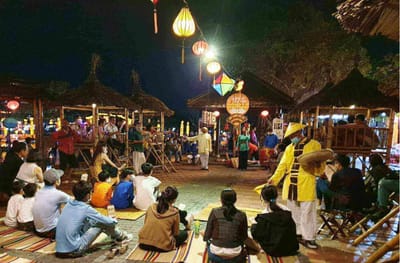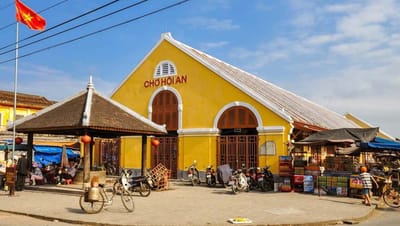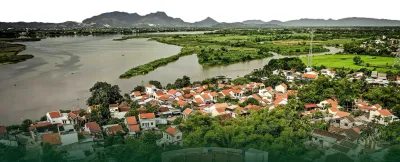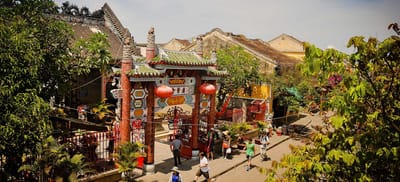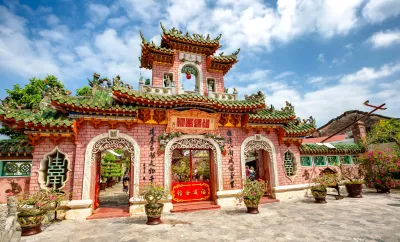Hoi An Seasonal Festivals 2025: Events & Calendar
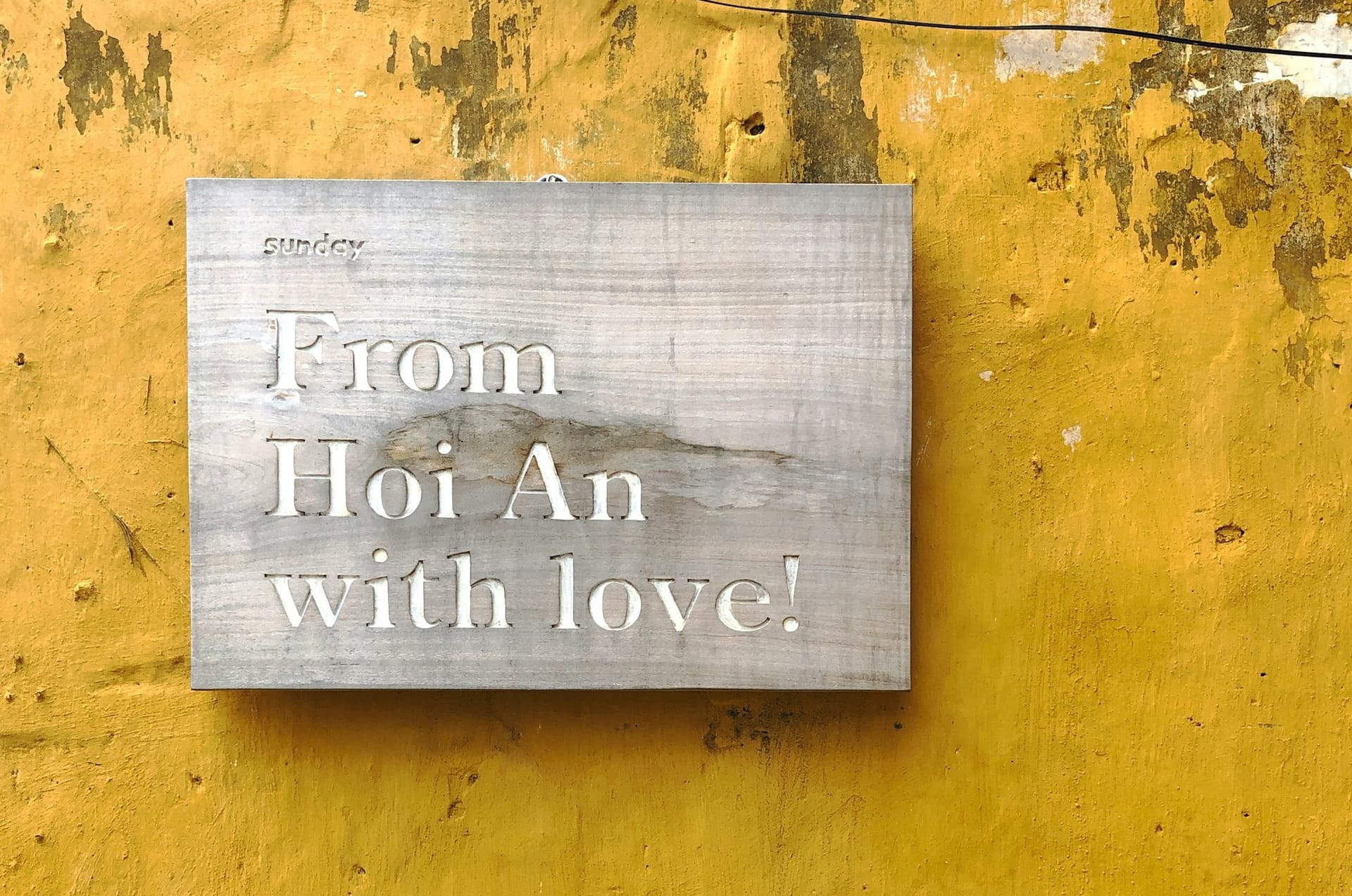
Executive Summary
Festival Highlights 2025: Hoi An's seasonal festival calendar features Lunar New Year/Tet (January 29–February 2: spring flower markets, fireworks, Bài Chòi singing contests), Lantern Festival (February 12: first full moon after Tet with maximum lantern displays), Hoi An–Japan Cultural Exchange (August: traditional performances, craft demonstrations), Mid-Autumn Festival (October 3–7: children's lantern parades, lion dances, mooncake tastings, national intangible heritage status), and UNESCO Anniversary (December 4: free heritage site admission). Unlike monthly Full Moon Lantern Festivals, these annual events intensify cultural programming, attract larger crowds, and showcase traditional Vietnamese celebrations rooted in agricultural cycles and religious observances. Book accommodations 3–4 weeks ahead for major festivals. Many businesses close during Tet; advance dining/activity reservations essential.
Hoi An's festival calendar reflects Vietnam's deep cultural rhythms—lunar calendar observances marking agricultural seasons, Buddhist holy days, and significant historical anniversaries. These seasonal celebrations transform the ancient town's nightly lantern atmosphere into amplified cultural experiences featuring special performances, traditional ceremonies, and community-wide participation.
Understanding Vietnamese Festival Culture
Lunar Calendar Foundation
Vietnamese festivals follow the lunar calendar rather than Gregorian dates, meaning annual events shift 10–30 days relative to Western calendars. This creates planning challenges for international travelers—you must convert lunar dates to Gregorian equivalents for specific years.
2025 Lunar-Gregorian Key Dates:
- 1st day of 1st lunar month = January 29, 2025 (Tet/Lunar New Year)
- 14th of 2nd lunar month = February 12, 2025 (Lantern Festival)
- 15th of 8th lunar month = October 6, 2025 (Mid-Autumn Festival)
- December 4 = Annual UNESCO anniversary (Gregorian date, fixed)
Cultural vs. Tourist Festivals
Hoi An's festivals divide into two categories:
Traditional Cultural Festivals:
Genuine Vietnamese observances predating tourism—Tet, Mid-Autumn, ancestor worship ceremonies. Local residents participate with sincere religious/cultural intent; tourism is secondary consideration. Authenticity high; commercial atmosphere moderate.
Tourism-Oriented Events:
Created specifically for visitor engagement—Hoi An–Japan Cultural Exchange, International Lantern Festival, Creative Craft Fairs. Still feature legitimate cultural content but designed with tourist appeal as primary objective. Authenticity varies; commercial atmosphere strong.
Both categories offer value; understanding distinctions helps align expectations with experience type desired.
[Link to: Hoi An at Night: Evening Activities for overall evening context]
Major Annual Festivals 2025
Lunar New Year (Tet) – January 29–February 2
Full Name: Tết Nguyên Đán (Festival of the First Morning of the Year)
2025 Dates: January 29 (New Year's Eve) through February 2 (official holiday ends; celebrations continue through week)
Significance: Vietnam's most important cultural celebration—welcoming new year, honoring ancestors, family reunions, hope for prosperity
Tet Traditions in Hoi An
Spring Flower Market (January 27–February 2):
Hoi An Stadium and main streets transform into vibrant flower markets selling apricot blossoms (hoa mai), peach blossoms (hoa đào), kumquat trees, orchids, and decorative plants. Vietnamese families purchase flowers and ornamental trees to decorate homes—the brighter and fuller the blossoms, the more auspicious the coming year. Tourists can browse the photogenic displays and purchase small potted plants as souvenirs.
Creative Craft Fair (February 1):
Showcasing handicraft products, handmade goods from Quang Nam province, and creative Tet decorations at 106 Bach Dang Street and An Hoi Park. Local artisans demonstrate traditional crafts—lantern making, wood carving, silk weaving—with opportunities to purchase authentic items directly from creators.
New Year's Eve Celebration (January 29, 7:00 PM–Midnight):
The ancient town hosts a spring parade at 7:00 PM featuring traditional costumes, dragon-lion dances, and music performances. Art show begins 11:00 PM. Fireworks launch at midnight over the Hoai River, creating spectacular reflections on the water. Thousands gather along the riverfront for this climactic moment welcoming the new year.
Bài Chòi Singing Contest (Ongoing from January 29):
UNESCO-recognized folk game competitions throughout the ancient town. Teams compete in traditional card game with musical verses—combination of singing, poetry, and chance. Audience participation encouraged; visitors can learn basic rules and join informal games.
Traditional Folk Games:
Human chess (cờ người), rope jumping, blindfolded drumming, and children's games activate public spaces throughout the festival period. These games connect contemporary visitors to centuries-old Vietnamese leisure traditions.
Ancestral Worship Ceremonies:
Vietnamese families prepare elaborate altars with fruit, flowers, incense, and special Tet foods (bánh chưng—square sticky rice cakes, giò lụa—Vietnamese pork sausage). Observe these family rituals respectfully; some households welcome friendly tourists to witness ceremonies and explain significance.
textTET PLANNING ALERT: Many restaurants, shops, and tour operators close January 29–31 as owners return to hometowns for family celebrations. Restaurants remaining open raise prices 20–50%. Book all dining and activities BEFORE January 25. Hotels fill 4–6 weeks in advance; reserve accommodations immediately upon confirming Tet travel plans[139][141][143][147].
![Alt text: Hoi An Ancient Town during Tet Lunar New Year festival with yellow apricot blossom trees lining the lantern-decorated streets, red festive banners hanging from traditional Vietnamese shophouses, crowds of families in colorful ao dai visiting spring flower markets, and dragon dancers performing in front of the illuminated Japanese Covered Bridge]
Lantern Festival (Tết Nguyên Tiêu) – February 12, 2025
Lunar Date: 15th day of 1st lunar month
Significance: First full moon after Lunar New Year; celebrates full transition into new year with lantern-focused traditions
This festival amplifies the monthly Full Moon Lantern Festival experience—the ancient town turns off electric lights, thousands of additional lanterns illuminate streets and river, and cultural performances intensify. Vietnamese families celebrate with particular enthusiasm as this represents the year's first major full moon observance.
Activities mirror monthly lantern festivals but scaled up: larger Bài Chòi tournaments, extended performance schedules, intensified floating lantern releases, and special vegetarian food offerings at markets and restaurants.
The February date typically coincides with pleasant weather (cool evenings, minimal rain), making this an ideal festival for first-time visitors seeking accessible cultural immersion without extreme crowds or challenging conditions.
[Link to: Hoi An Lantern Festival Guide for monthly festival details and February enhancement]
Hoi An–Japan Cultural Exchange – August 1–3, 2025
Edition: 21st Annual Event
Theme: Celebrating historical Japanese-Vietnamese connections through Hoi An's 16th-17th century trading port heritage
Location: Ancient Town central areas, Japanese Covered Bridge vicinity
Featured Activities
Traditional Japanese Performances:
Taiko drumming, shamisen music, traditional dance, and martial arts demonstrations by visiting Japanese cultural troupes. These performances occur on outdoor stages allowing large public attendance.
Craft Demonstrations:
Japanese and Vietnamese artisans work side-by-side demonstrating traditional techniques—pottery, calligraphy, textile weaving, woodblock printing. Comparative demonstrations highlight cultural exchange and mutual influence over centuries.
Samurai Exhibitions:
Costumed performers showcase samurai armor, swordsmanship techniques, and feudal-era Japanese warrior culture. Educational presentations explain samurai class connections to merchant activities that linked Japan to Hoi An during the Red Seal Ship era (1604–1635).
Lantern Traditions:
Special focus on Japanese lantern designs vs. Vietnamese styles, exploring how Hoi An's iconic lanterns blend both cultural influences.
Culinary Cultural Exchange:
Japanese and Vietnamese chefs collaborate creating fusion dishes, while separate areas offer authentic cuisine from both cultures. Food demonstrations explain ingredient sourcing, preparation techniques, and symbolic meanings.
Historical Lectures:
Scholars present research on Hoi An–Japan trade history, the Japanese Quarter's development and eventual disappearance, architectural influences, and contemporary cultural preservation efforts.
This festival appeals particularly to history enthusiasts and travelers interested in cultural exchange narratives beyond typical tourist entertainment.
Mid-Autumn Festival (Tết Trung Thu) – October 3–7, 2025
Lunar Date: 15th day of 8th lunar month (full moon: October 6)
National Status: Recognized as National Intangible Cultural Heritage (2023)
Significance: Children's festival, harvest celebration, family reunion, moon worship
Cultural Background
Mid-Autumn Festival originated in China's harvest thanksgiving traditions, adapted in Vietnam to emphasize children's wellbeing and family unity. The full moon represents completeness and reunion—Vietnamese families gather to appreciate the moon's beauty, eat mooncakes, and light lanterns symbolizing brightness and prosperity.
Legend tells of Cuội—a Vietnamese folk hero said to live on the moon. Children's lantern parades reenact his journey, while mooncakes represent the moon's roundness and fullness.
2025 Hoi An Program
Official Events (Organized by Hoi An Cultural Heritage Management Center):
October 4 – Full Moon Festival Night:
Hoi An Park hosts lion-dragon dance performances, Mid-Autumn themed art shows, and traditional music ensembles. This serves as the festival's ceremonial centerpiece with formal cultural programming.
October 4 – "Music and Moon" (106 Bach Dang Street):
Folk songs, children's rhymes, and ethnic instrument performances create interactive musical experience especially designed for children and families. Audience participation encouraged.
October 3–6 – "Hoi An Ancient Town Night":
Recreation of early 20th-century Hoi An lifestyle under traditional lantern glow. Historical reenactments, period costumes, and ambient traditional activities transport visitors to pre-modern Hoi An.
October 6 – Grand Lantern Parade (5:30 PM Start):
Children carrying colorful lanterns (star-shaped, animal-shaped, character-shaped) parade through ancient town streets spreading festive cheer. The parade route winds from Tran Phu Street through main thoroughfares, culminating at the riverfront. Spectators welcome; bring cameras for photogenic children's processions.
Ongoing Throughout Festival:
- Traditional Mid-Autumn feast displays (Museum of Folk Culture)
- Photo exhibitions documenting festival history
- Continuous lion dance performances at various locations
- Mooncake tastings and traditional food vendors
- Cultural workshops teaching lantern making and moon cake preparation
Organic Street Celebrations
Beyond official programming, Hoi An's streets fill with spontaneous celebrations:
Children's Lion Dances:
Groups of children (some as young as 3–4 years old) don oversized lion costumes, bang drums, and parade through alleys in chaotic, endearing performances. While less polished than professional troupes, these grassroots displays capture authentic community spirit.
Acrobatic Teams:
Trained performers execute impressive stunts—climbing metal poles, breathing fire, performing dragon dances with synchronized movements. These spectacles often occur at hotels, resorts, or along Phan Chau Trinh Street.
Family Lantern Walks:
Vietnamese families stroll the ancient town carrying lanterns while children sing traditional rhymes. The atmosphere blends reverent cultural observance with joyful celebration—authenticity without staged tourism performance.
Mooncake Tradition:
Bakeries and markets sell special mooncakes (bánh trung thu)—dense pastries filled with sweet lotus or red bean paste, sometimes containing salted egg yolks representing the moon. Families gift mooncakes to relatives, friends, and business associates. Visitors should taste at least one mooncake to participate fully in festival culture.
textFAMILY-FRIENDLY HIGHLIGHT: Mid-Autumn Festival is Hoi An's most child-centric celebration. Children dominate activities—lantern parades, lion costume performances, traditional games. Families traveling with kids find this festival exceptionally welcoming and engaging for young participants[86][136][138][140].
[Link to: Hoi An at Night: Evening Activities for complementary evening activities]
[Link to: Inside Hoi An Night Market for mooncake vendors and festival food]
UNESCO World Heritage Anniversary – December 4, 2025
Anniversary: 26th year since Hoi An's UNESCO World Heritage designation (December 4, 1999)
Special Recognition: 8th year since Bài Chòi folk art UNESCO listing
Free Admission Day:
All heritage sites within the ancient town waive entry fees on December 4 annually. Visitors access museums, ancient houses, assembly halls, and cultural venues without purchasing the standard 120,000 VND ticket. This creates exceptional value for budget travelers and encourages broad public engagement with heritage preservation.
Commemorative Events:
- Special cultural exhibitions documenting Hoi An's heritage journey
- Traditional performance showcases
- Bài Chòi demonstrations and competitions
- Heritage conservation presentations
- Academic lectures on preservation challenges and successes
The anniversary celebration emphasizes education and awareness—organizers use free admission to promote understanding of why Hoi An received UNESCO designation and what ongoing efforts sustain that status.
Crowds surge significantly on December 4 due to free entry. Arrive early (8:00–9:00 AM) to visit popular sites before congestion peaks.
Secondary Festivals & Events
Vesak (Buddha's Birthday) – May 2025
Lunar Date: 14th or 15th day of 4th lunar month (varies by temple tradition)
Activities: Colorful processions, offerings at pagodas (Quan Cong Temple, Phuc Kien, Chaozhou), vegetarian feast sharing, lantern lighting, and prayer ceremonies
Vietnamese Buddhists celebrate with particular devotion—temples overflow with flowers, incense, and devotees making merit. Tourists respectfully observing temple ceremonies witness authentic religious practice.
Village Deity Festivals (Lễ Hội Làng) – Various Dates
Throughout the year, villages surrounding Hoi An celebrate their protective deities with communal festivals:
Cau Bong Tra Que (February 4, 2025):
Tra Que Vegetable Village ceremony praying for bountiful harvests and favorable weather. Traditional agricultural rituals reflecting farming community beliefs.
Thanh Ha Pottery Village Festival (Varies):
Celebrating 500+ years of ceramic traditions with demonstrations, workshops, and craft competitions.
Kim Bong Carpentry Village Festival (Varies):
Honoring woodworking heritage through exhibitions showcasing traditional joinery techniques and contemporary creations.
These smaller festivals offer glimpses into authentic rural Vietnamese life beyond tourist-focused ancient town activities. Visiting requires transportation (bicycle or motorbike) to surrounding villages, but rewards travelers seeking grassroots cultural engagement.
International Events 2025
Hoi An International Lantern Festival (October 2–6, joint with Da Nang):
Regional event elevating local lantern traditions to international scale. Performances at An Hoi Sculpture Garden, Ancient Town, and Da Nang riverfront create multi-venue celebration.
"Fly Over the Heritage Region" (June 6, Hoi An Memory Island):
High-tech spectacular featuring 600-drone performance, updated Hoi An Memories show, fireworks display, and paragliding with pyrotechnics. Fusion of technology and heritage storytelling.
These modern tourism events lack the deep cultural authenticity of traditional festivals but offer unique contemporary entertainment leveraging Hoi An's heritage as thematic foundation.
[Link to: Hoi An Memories Show Review for standard performance details vs. special June event]
Festival Planning Strategies
Accommodation Booking
Major Festivals (Tet, Mid-Autumn):
Book 4–6 weeks minimum in advance. Riverside hotels and boutique properties in ancient town core sell out first. Prices rise 30–50% during peak festival periods.
Secondary Festivals (Vesak, village celebrations):
Standard booking (1–2 weeks ahead) suffices. Minimal price increases; normal availability.
UNESCO Anniversary (December 4):
Day-trip destination for many domestic tourists; overnight accommodation less strained. Book 1–2 weeks ahead for moderate pricing.
Dining Reservations
Tet Critical:
Many restaurants close entirely January 29–31. Those remaining open require advance reservations and charge premium rates. Book tables before January 25. Consider cooking classes or hotel dining packages if independent restaurant options are scarce.
Other Festivals:
Restaurants operate normally though popular venues fill quickly during peak festival hours (6:30–9:00 PM). Reservations recommended but usually possible 1–2 days ahead.
Crowd Management
Strategic Timing:
- Tet: Visit before January 29 or after February 2 to experience decorations without business closures
- Mid-Autumn: October 3–4 for setup and early activities; October 6 evening for grand lantern parade
- UNESCO Anniversary: Arrive 8:00 AM for heritage sites before crowds; leave by 11:00 AM to avoid peak congestion
Alternative Perspectives:
Major festivals create maximum cultural atmosphere but also maximum crowds and costs. Travelers prioritizing intimacy over spectacle may prefer regular monthly Full Moon Festivals (similar lantern ambiance, fewer tourists, normal pricing).
What to Pack
Tet Festival:
- Festive red clothing (Vietnamese associate red with luck and prosperity; wearing red shows cultural awareness)
- Cash for purchases (many vendors don't accept cards during holidays)
- Camera for flower markets and fireworks
- Light jacket (January evenings cool, 18–22°C)
Mid-Autumn Festival:
- Comfortable walking shoes (following lantern parades, children's activities)
- Snacks for children (long festival hours; keep kids energized)
- Cash for mooncake purchases and street food
- Insect repellent (outdoor evening activities)
All Festivals:
- Portable phone charger (extended photography drains batteries)
- Small bag for purchases
- Patience and flexibility (festival schedules often run late; events may change)
Cultural Sensitivity
Photography Etiquette
Religious Ceremonies:
Avoid flash photography during ancestral worship, temple offerings, and prayer rituals. Ask permission before photographing altars or sacred objects.
Children's Events:
Request parent permission before photographing children in costume or parade formations. Many families happily consent; some prefer privacy.
Respectful Distance:
Observe family celebrations from sidelines unless explicitly invited to participate. Vietnamese hospitality often extends invitations; wait for welcoming gestures rather than assuming access.
Participation Boundaries
When to Join:
Public street festivals (lantern parades, lion dances, folk games), market activities, and performance audiences welcome all participants.
When to Observe:
Private family ancestral worship, home-based ceremonies, and solemn religious rituals at pagodas require respectful observation without direct participation unless invited by practitioners.
Gift Giving:
If invited to family Tet celebrations, bring small gifts—fruit basket, imported chocolates, or flowers (avoid white or yellow—funeral associations). Refuse gifts twice before accepting (Vietnamese custom); accept on third offer.
[Link to: Floating Lanterns Experience for participatory ritual guidance]
[Link to: Seasonal Festivals in Hoi An for current page self-reference]
Conclusion
Hoi An's seasonal festival calendar reveals Vietnamese culture's agricultural roots, Buddhist spiritual foundations, and contemporary efforts to balance tradition preservation with tourism development. These annual celebrations transform the ancient town from nightly lantern destination into dynamic cultural landscape where centuries-old traditions persist alongside modern interpretations.
The festivals operate on dual levels—Vietnamese families participate with genuine religious and cultural intent, maintaining practices passed through generations, while international visitors experience accessible introductions to Vietnamese traditions without requiring deep cultural expertise or language fluency. This duality succeeds when both groups approach festivals respectfully: locals welcoming curious outsiders into their celebrations, visitors engaging thoughtfully rather than treating traditions as mere tourist attractions.
Timing Hoi An visits to coincide with major festivals—Tet's exuberant new year optimism, Mid-Autumn's child-centered lantern magic, or UNESCO anniversary's heritage celebration—adds cultural depth to standard ancient town tourism. However, these festivals demand advance planning, higher budgets, and crowd tolerance. Travelers seeking authentic Hoi An character without festival complications may prefer regular monthly Full Moon Lantern Festivals or quiet exploration during shoulder seasons.
Regardless of timing, Hoi An's festivals embody the ancient town's core identity: a living cultural landscape where heritage preservation enables contemporary celebration, where Vietnamese traditions welcome international participation, and where centuries-old practices adapt to modern contexts while maintaining their essential spiritual and communal significance. Participating in these seasonal rhythms connects travelers to something larger than individual tourism experiences—the ongoing cultural life of communities maintaining traditions across generations, seasons, and the inevitable changes that time brings to even the most carefully preserved heritage sites.
No spam, no sharing to third party. Only you and me.


